How to Give Brand Accounts Permission to Whitelist Your TikTok Content
TikTok whitelisting allows brands to turn creator content into awesome ads. Here’s how to give brands access to your TikToks for whitelisting.
Despite popular belief, the TikTok algorithm isn’t a total mystery. This post explains how TikTok ranks content and ways brands can “beat” the algorithm.


If you’re trying to figure out how to beat the TikTok algorithm, we get it.
The platform is popping off right now for brands and creators alike.
But all of that popularity comes with crowds of competition and countless videos.
Breaking through the noise means learning exactly how the TikTok algorithm works.
Thing is, there are so many myths out there about TikTok’s ranking system. That’s why we wrote this post with proven and actionable tips to help brands grow.
And if you want to cut to the chase, jump to our tactics section below!
TL, DR? 👩🏫
Skip to Section 👇How TikTok Ranks Videos (Explained) |
The TikTok algorithm is the app’s system that decides the videos you see in your feed.
Rather than present posts chronologically, algorithms serve content based on relevancy. The TikTok algorithm determines what’s “relevant” through a variety of factors. This includes which videos and accounts you’ve watched or engaged with in the past.
The idea here is simple: TikTok predicts what you want to watch and serves it by default.
Chances are you see a handful of similar types of TikTok posts on your #ForYou page. If TikTok recognizes that you watch beauty tutorials and cat videos, that’s what you’ll continue to see. This is a simplified example of the algorithm at work.
Food for thought: 97% of all video views on TikTok come from the #ForYou page
That’s why understanding how the TikTok algorithm works is crucial for brands. Maximizing your viewership starts with learning about the app’s ranking factors.
The ins and outs of social media algorithms can get complicated. Let’s keep it simple:
TikTok uses AI and machine learning to rank videos. The algorithm is capable of figuring out “what” a video is and who’s likeliest to engage with that video.
A few years back, TikTok stated that #ForYou results are presented based on a few specific factors. Here’s a quick summary of how TikTok’s ranking system works according to the app:
The more you use TikTok and interact with content, the more tailored your feed becomes. Users can adjust their recommendations through in-app features and the “Not Interested” icon.
The fact that TikTok is served algorithmically is both a blessing and a curse for brands:
Thing is, accounts with relatively few followers regularly make the #ForYou page. Getting more views on TikTok requires trial-an- error and a little bit of luck.
TikTok isn’t explicit about which ranking factors hold the most weight. That said, user interactions (specifically comments, shares and saves) definitely matter. Engagement on TikTok is a snowball effect. The more people engage, the more fuel for the algorithm.
This explains the common threads between the types of videos that dominate the FYP. Videos that drive discussions or share recommendations often go viral. For example, videos shouting out “best” products are prime for debate among commenters.
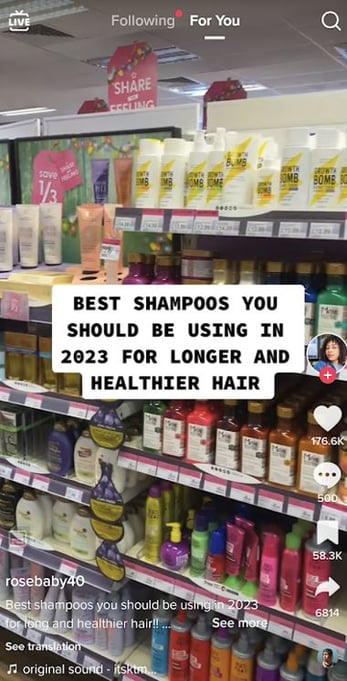
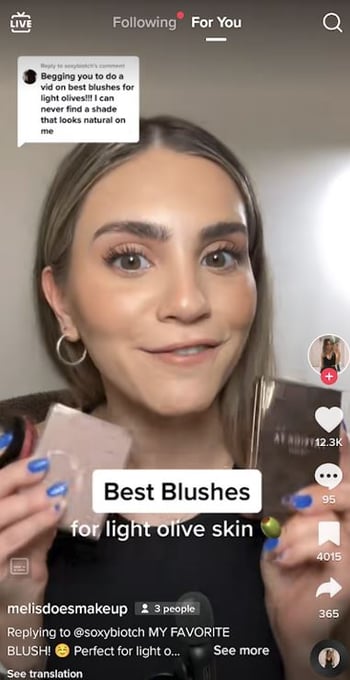
Source: @rosebaby40 / @melisdoesmakeup
Many marketers are buzzing about TikTok's “new” algorithm. Thing is, social algorithms aren’t static.
The more the app evolves, the more the TikTok algorithm changes. Here are three notable developments within the past year which have impacted how the app serves videos:
Even with these changes, TikTok’s ranking system isn’t radically different than it used to be.
Okay, so you have a high-level understanding of how the app ranks video. Nice!
Now, let’s dig into myths and misconceptions about the algorithm. Keep these in the back of your mind in your quest to grow your TikTok account.
TikTok explicitly states that follower count is not a ranking factor.
This explains how micro-influencers on TikTok and other small accounts go viral. In some cases, it seems that TikTok prefers smaller accounts over big ones.
How so? Below is an example of a search for “Aquaphor” on TikTok. Note that each of the creator videos has 10x the views of content from Aquaphor’s official account. Some of these creators only have a couple hundred or thousand followers themselves.
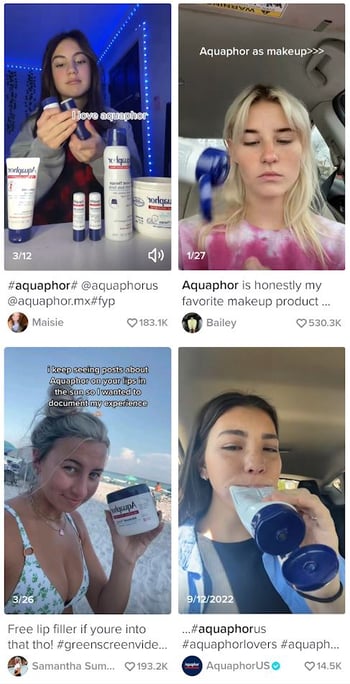
Wild, right? That said, having a larger audience obviously has its benefits. It’s much easier to drive initial engagement and rank if you have thousands of followers versus a dozen.
The takeaway here is that the app does not exclusively prioritize big accounts. TikTok’s level playing field when it comes to audience size is valuable to both brands and creators.
To say that content moves quickly on TikTok would be an understatement.
That’s why trying to optimize your post times down to the minute or hour is moot.
For starters, content on TikTok ranks algorithmically and not chronologically. Variables such as time zone and target audience mean that “optimal” times are relative.
That’s not to say you should post at random or in the middle of the night on weekends. Instead, use your own data from TikTok analytics to make an informed decision. Some insiders recommend publishing an hour or so before your peak engagement periods.

Source: YouTube
Still, there’s too much conflicting evidence to definitely define the "best" time to post on TikTok.
Piggybacking on the point above, timing on TikTok is tricky. This not only applies to when you should post but also how long it takes for a video to gain traction.
Some videos go viral overnight. Others are a slow burn performance-wise. TikTok actually acknowledges this phenomenon in an interview on their YouTube channel. Meanwhile, there’s evidence from TikTokers citing gradual view-count growth as the norm these days:
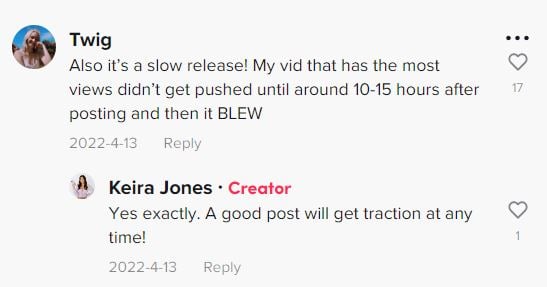
Either way, don’t assume a video is a dud after only a couple of hours. Peaking takes time!
Modern social media marketing often feels like a constant battle against algorithms, right?
That’s why marketers often talk about beating these systems. It’s a fight for reach!
Well, we know a thing or two about how the TikTok algorithm works firsthand. Our creators earned over 23.6 million loops last year alone! The good news is that improving your rankings as a brand doesn't have to be a guessing game.
Below are our actionable tips for beating the TikTok algorithm and increasing your reach.
TikTok notes that audio choice impacts engagement and brand recall. Picking the right audio can help you hook viewers. This leads to higher watch times and engagement.
All the more reason for brands to take advantage of TikTok’s Commercial Music Library. Sounds in the CML are approved for business use. That said, these songs regularly go viral on behalf of brands.
For example, this post for Spanx earned over 200,000 views and 24k Likes with a song from the CML. This same track has been used by massive brands like Calvin Klein, Levi’s and Tree Hut.
The takeaway? Audio is a low-hanging way to improve your chances of getting promoted by the algorithm.
Food for thought: TikToks have serious staying power when it comes to social search.
For example, check out this search from 2023 that returns top results from years ago.
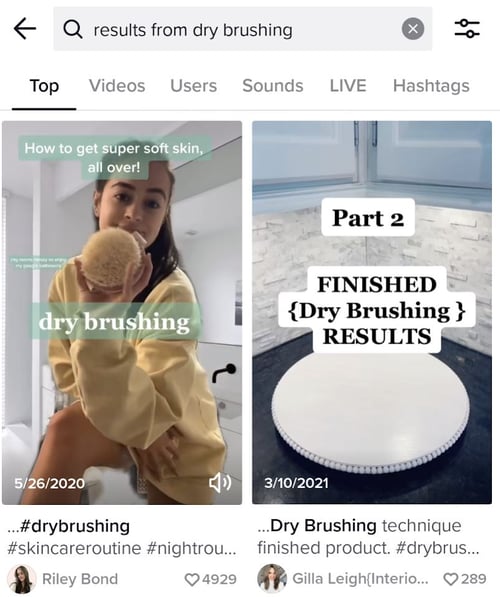
This highlights how TikTok serves relevant content and not just what’s new. Two quick ways to boost your social search presence:
Psst! For a deeper into how social search works, check out our TikTok SEO webinar.
Conventional wisdom says that TikTok prioritizes videos made on their app.
This is sort of an unspoken rule of thumb that applies to most social platforms. The concept is simple: TikTok wants users to engage and experience all of its native features.
That means brands should prioritize the following:
Of course, not every video will perform way better (or worse) because it was made directly on TikTok. These are just straightforward tips to satisfy the algorithm when in doubt.
For example, we’ve seen recent speculation that TikTok prioritizes videos made via CapCut. Note that CapCut is owned by TikTok’s parent company, ByteDance.

Source: Reddit
Is it a coincidence that many viral videos use templates and edits from CapCut? Consider how so many brands recently went viral thanks to CapCut's boat trend which has over 15 billion views.
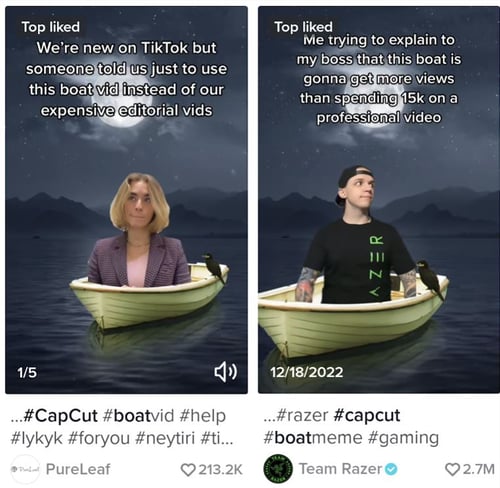
Every brand account is different in terms of which videos gain the most traction. Just remember that metrics like video completion rate have a big impact on your visibility. Keep an eye on your TikTok analytics to see what your audience wants. Then, create similar types of videos in the future.
Many marketers rack their brains about how often and when to post on TikTok. We recommend creating a TikTok marketing strategy that’s consistent versus obsessing over “optimal times.”
That’s why the best way to beat restricted reach on TikTok is with the help of creators.
Let’s say you have 10,000 followers on your brand’s TikTok account. Your reach is largely limited to those 10,000 people (and only a fraction will actually see your post).
However, let’s say you partner with 30 micro-influencers with ~5,000 followers each. This increases your potential reach exponentially.
Each interaction between you and a creator is a positive signal for the TikTok algorithm, too. Tags, comments, Likes and everything in between. If you’re regularly earning UGC and posts from creators, you boost your visibility long-term.
With an always-on influencer marketing strategy, you don’t have to sweat every TikTok algorithm change. There’s a reason why brands with hundreds of thousands of followers still partner with micro-influencers.
We get it: social algorithms can be fickle and frustrating for brands.
But understanding how they work is key to growing your presence.
Cracking the TikTok algorithm is largely a numbers game. The more interactions and people posting about your brand, the more likely you are to get discovered.
And if your brand needs TikTok creator content at scale, Statusphere can help.
Our micro-influencer marketing platform matches brands with creators using 250+ first-party data points. Through our vetted creator community and streamlined fulfillment technology, Statusphere helps brands earn high volumes of authentic, guaranteed content.
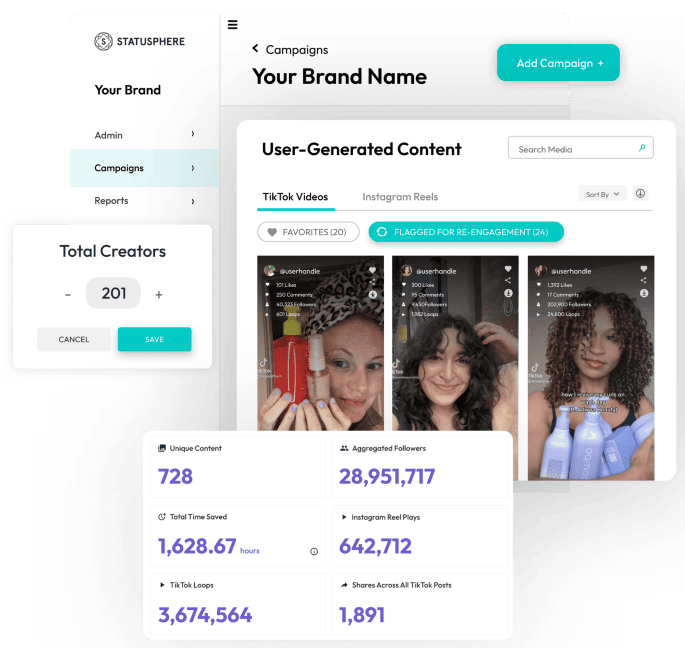
We built our software specifically to support brands with an always-on influencer strategy. We’ve already generated 75,000+ pieces of content for 400+ brands.
Want to learn more about how our platform works? Get in touch with one of our experts to see how we can scale your influencer marketing efforts in a fraction of the time it'd take in-house.
This article was first published in May 2020. It was last updated April 24, 2023.
TikTok whitelisting allows brands to turn creator content into awesome ads. Here’s how to give brands access to your TikToks for whitelisting.
How does the 2022 Instagram algorithm work? This guide breaks down what brands should know about the algorithm and how to adapt to new Instagram...
New data from TikTok confirms just how much the customer journey is changing. Here's what the numbers mean and how brands can reach buyers on TikTok.
Be the first to know about the latest tools, trends and strategies in influencer marketing for brands.